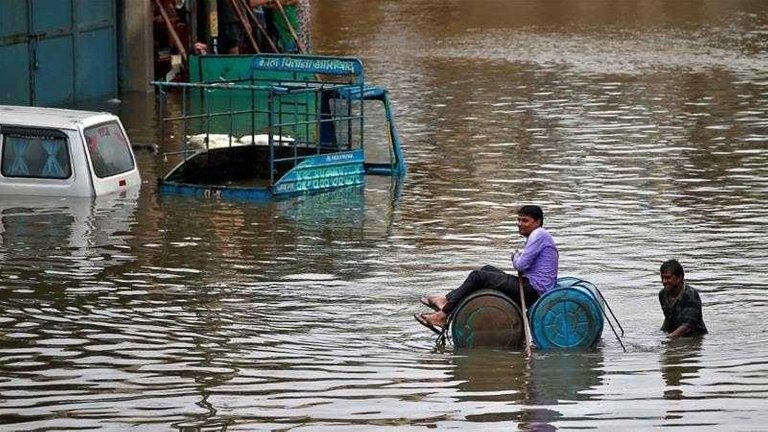For the third year in progression, India's rainstorm season has conveyed surges in the northwest and the upper east, while southern parts of the country have encountered a precipitation deficiency. Precipitation extremes have extended triple over the span of the latest couple of years and now connect completed all of central India – from Gujarat to Odisha. The surges of 2017 are extremely dependable with this case; the moistness gets from the northern Arabian Sea and not from distresses in the Bay of Bengal as one would ordinarily envision.
Considering the total precipitation over the entire rainstorm season from June to September, an early tempest tends to convey ample precipitation while better than anything ordinary precipitation is only occasionally watched when they are conceded.
The start of the tempest has been delayed moderately reliably since 1976, when there was an organization move in climate around the world – from a fragile to a strong El Niño period. Since this time, storms have moreover been completing sooner – pretty much seven days from the complete of September – so the length of the tempestuous season has been stuffed. This is despite the about 10% decrease in All India Monsoon Rainfall, and a development in the spatial variability of rainstorm precipitation, since the 1950s.
The natural change affect
In the midst of the tempest season, there are for the most part subjective "break time frames" when there isn't generally any precipitation. These periods are connected with structures moving northwards from the tropical area. Each available datum and models-blended with-data (known as reanalysis) demonstrate that an unnatural climate change is shortening the length of the "dynamic periods" when it downpours, while stretching the break time periods. They also exhibit that natural change is lessening the extremes in the dynamic time allotments while growing them in the break time spans.
In this way, essentially everything about the rainstorm is changing – precipitation compel, traverse, repeat and spatial spread.
We can't be by and large certain if this is in light of an overall temperature adjustment – in which case it could be ceaseless and animate – or if the rainstorm system will come back to a more "normal" state. Until the point that we have various all the more significant lots of data and reanalysis, an aggregate parcel of the an unnatural climate change influence from ordinary environment capriciousness, for instance, on account of El Niño may not be possible.
The key request right directly is whether the truncated length of the stormy season could provoke extended rainstorm extremes by trying to squash near measures of precipitation into a shorter period, or whether an overall temperature adjustment is causing shifts in the term, power and repeat of precipitation.
Looking at the tempest
Looking at the South Asian tempest has been troublesome. A rich vein of whole deal data yields exceptional encounters yet likewise raises new issues and stances bona fide troubles to environment models old and new. Regardless, now we do understand that precipitation extremes in the midst of the tempest are arbitrary to adjacent warming.
We also understand that the whole deal designs we are seeing – lessening mean precipitation, growing spatial variability of precipitation, and a triple rising in precipitation extremes – are connected with a weakening tempest wind stream and a diminishment in the amount of rainstorm melancholies from the Bay of Bengal. Really, these discouragements used to be accountable for about an expansive bit of the precipitation in the midst of the entire rainstorm.
Along these lines, if there are less rainstorm demoralizations in the Bay of Bengal, what is driving these precipitation extremes?A new paper I co-formed with Roxy Mathew Koll of the Indian Institute of Tropical Meteorology finds that warming of the land in northwest India and Pakistan influences a weight to compel that drives strong close surface breezes from the northern Arabian Sea to central India and passes on enough clamminess to more than alter for the crippling tempest course and the reducing storm distresses from the Bay of Bengal. This in like manner illuminates the triple augmentation in precipitation extremes despite the reducing design as a rule rainstorm precipitation.
Diverse segments at play
Distinctive segments influencing the rainstorm – which brings more than 80% of the yearly precipitation to South Asia – consolidate the impact of El Niño and its accomplice La Niña. By then there's the warming and cooling of the Indian and Atlantic oceans – the Indian Ocean Dipole and the Atlantic Niño. All these expect a section in the rainstorm, yet it isn't for the most part clear which impacts what, and how.
Despite these movements and the decreasing example, precipitation toward the complete of most seasons remains inside 10% of the broad stretch typical. Regardless, with the assortments across finished space extending, that suggests little to farmers dependent on rain-fed cultivating. A couple of territories, for instance, northern Karnataka and central Maharashtra have starting late had precipitation lacks close half.
Whole deal precipitation diminish is focusing, especially in case it is caused via oceans warming up in view of ecological change. This can change the land-ocean temperature separate and diminish the sogginess ask for over land in the midst of the rainstorm.
Henry Blanford, official of the India Meteorological Department in the late nineteenth century, insinuated the vaporous lead of the tempest as its progressions. These have obviously extended now, and made created by analysts more troublesome. In any case, there is a silver covering. We at present understand that non-close-by impacts are more basic; it is less complex to track them and upgrade our deciding to the point where specialists have sufficient time to act before a surge or a whirlwind.

Additionally, since mean precipitation has remained inside 10% of the broad stretch ordinary, enormous water supplies are silly. The bona fide significant scale plan should be tied in with getting the storms, either by water procuring or agroforestry.